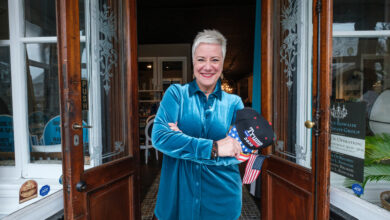A Push for Zoning Reform in Connecticut

[ad_1]
A broad-based zoning reform movement is gathering momentum in Connecticut, as racial justice activists step up their efforts to break down barriers to affordable housing and economic opportunity at a time of national awakening around such issues.
DesegregateCT, an all-volunteer organization founded by Sara C. Bronin, a Mexican-American lawyer and architect, is lobbying state lawmakers to enact sweeping reform by amending statutory zoning guidelines to force suburban and rural communities to allow more multifamily housing, particularly near transit centers and downtowns.
“I joke about Connecticut being ‘The Land of Steady Habits,’ ” said Ms. Bronin, who is married to the mayor of Hartford, Luke Bronin. “We tend to do the same thing over and over, including building the same kind of housing: detached single-family homes on large lots.” While single-family homes on sprawling lawns may define many of these suburban towns, longstanding regulations that prevent denser housing tend to keep out less affluent residents and people of color.
On a parallel track, Open Communities Alliance, a housing advocacy group, is calling on the affluent suburb of Woodbridge to amend its zoning code to allow for multifamily housing in most every residential district in town. The request for a zoning amendment accompanies the group’s application to build a four-unit residential building on 1.5 acres in a single-family zone; two of the units would be reserved for low-income renters.
“We’re here today to open Woodbridge,” declared Erin Boggs, the alliance’s executive director, at the first public hearing last November on the application before the planning and zoning commission.
The heightened calls for zoning reform in Connecticut align with momentum behind the issue nationally, particularly in the states of Oregon, California, Massachusetts and New Jersey, said Noah Kazis, a legal fellow at New York University’s Furman Center. Lagging housing production has exacerbated the affordability crisis in the Northeast, while an abundance of scholarship has shed increasing light on the impacts of “a century of evermore restrictive zoning at the local level,” he said.
Add to that the national focus on law enforcement abuse following the death of George Floyd at the hands of the police in Minneapolis, and the racial inequities brought into stark relief by the pandemic, and you have a “window of opportunity” for meaningful reform, Ms. Boggs said.
“This is a moment that we need to seize,” she said. “But it’s really only the beginning of a concerted effort to make some changes that, hopefully, will have some wider support.”
While some 60 housing, environmental, architectural, municipal and charitable organizations have joined the DesegregateCT coalition, the movement is also generating considerable pushback. In recent Zoom panel discussions on Facebook, some Republican municipal leaders have accused zoning reform advocates of trying to strip communities of local control.
“Who do you trust to make local zoning guidelines and standards in your town — your town or a central office in Hartford?” said the newly elected State Representative Kimberly Fiorello, of Greenwich, in a January panel discussion. Ms. Fiorello made local control of zoning an issue in her campaign last fall.
She is among 14 Republican co-sponsors of a joint resolution proposing a state constitutional amendment “to permit municipalities to enact and enforce zoning restrictions without regional or state interference.”
And in Woodbridge, about a dozen residents who live close to the Open Communities development site have hired a lawyer, Timothy Herbst, to represent them in opposing the application. Mr. Herbst, the former First Selectman of Trumbull and a 2018 Republican gubernatorial candidate, said the proposal to put multifamily housing in every residential district in town is “extreme” and would detrimentally impact the town’s infrastructure, traffic and groundwater.
“These are all things that a community has every right to consider,” he said. “I think Open Communities Alliance owes the town an apology — their application is essentially saying that the planning and zoning commission doesn’t matter.”
The alliance’s proposal would require multifamily structures to conform to the same size and setback requirements as single-family homes.
Housing in Woodbridge currently consists almost wholly of single-family homes on large lots — only 0.2 percent of the town’s land area permits two-family dwellings, Ms. Boggs said. The alliance argues that this history of restrictive zoning has effectively walled it off to lower-income and minority families.
The town’s demographics contrast sharply with those of neighboring New Haven. According to state economic profiles, the median household income of $138,000 in Woodbridge is more than triple that of the city’s, and fewer than 10 percent of the town’s roughly 9,000 residents are Black or Latino, compared to 60 percent in New Haven.
If their loud knock on Woodbridge’s door is not answered, the alliance, which has partnered with a fair-housing clinic at Yale Law School, has made clear they are prepared to go to court. “There are different legal avenues to pursue if it becomes necessary,” Ms. Boggs said. “There is the concern that the town is not following the state’s zoning and planning laws, the concern that they are violating the federal Fair Housing Act, and there is the issue with what we see as the state’s failure to enforce its zoning laws. If the state ends up being a defendant, the resolution of the case could involve changes that are statewide.”
Ms. Bronin said she hoped that what’s unfolding in Woodbridge would give a sense of urgency to town policymakers elsewhere in the state to update their own zoning codes “so they’re not in the cross-hairs of a lawsuit.”
A state zoning “atlas” compiled by the organization after months of gathering data shows that of the three million zoned acres in Connecticut, about 90.6 percent is zoned for single-family homes as of right (meaning no public hearing is required).
By comparison, only 28.5 percent allows for two units as of right, 2.3 percent allows for three units, and 2 percent allows for four or more. Eight towns don’t allow any multifamily housing at all.
Ms. Bronin pointed to those zoning hurdles as a primary reason that Connecticut is so highly segregated by race and income. More than two-thirds of people of color live in just 15 of the state’s 169 municipalities, according to a recent report from the NAACP Legal Defense and Educational Fund.
“Our zoning code has made housing too expensive,” she said. “And we have locked in what is essentially an aging population. We are one of the oldest states in the country and getting older.”
Although legislative language is still being worked out, the coalition’s platform calls for towns to be required to allow accessory dwelling units (sometimes called in-law apartments) to be built anywhere there is a single-family dwelling and without a host of onerous restrictions. They also want two- to four-unit housing to be allowed as of right within a quarter-mile of a “main street” in towns with populations over 7,500.
And they want towns to be required to zone for housing with four or more units on 50 percent of the lot area within a half-mile of a transit station.
One of the coalition’s more surprising members is the Connecticut Conference of Municipalities, which advocates for municipalities across the state. Joe DeLong, the executive director, acknowledged that the organization has “vehemently” protected local control and local decision-making for years, but said that more recently, it has begun focusing on racial equity in a number of areas.
While there is certainly disagreement among his membership around zoning issues, many municipal leaders are open-minded about finding ways to create more housing opportunity — perhaps more so than state lawmakers, Mr. DeLong said.
“Legislators want to point to any opposition in towns and cities as an excuse for them not to take action,” he said. “They want us standing up and screaming ‘No.’ When we come forward and say, we think something needs to be done, that makes some of them very uncomfortable.”
State Senator Saud Anwar, a physician from South Windsor who has been a vocal proponent for zoning reform, said it was time for people in the suburbs “to look beyond their belief that they live on an island — they do not. This is the time to get all hands on deck and try to create an equitable and fair mechanism for increasing affordable housing.”
For weekly email updates on residential real estate news, sign up here. Follow us on Twitter: @nytrealestate.
[ad_2]
Source link






